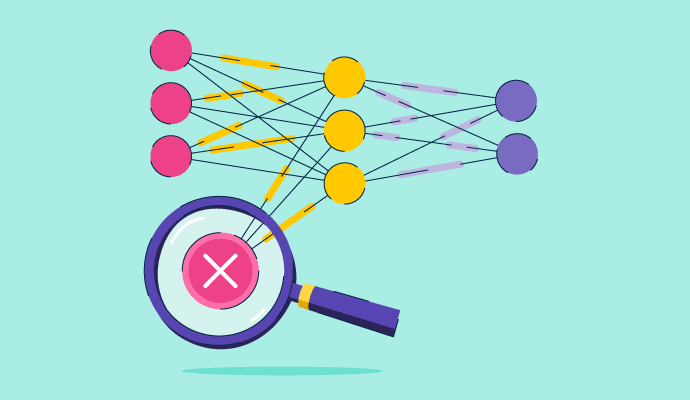
Backpropagation sits at the heart of neural networks, where it helps deep learning models produce more accurate results.
By systematically adjusting internal parameters, backpropagation enables models to minimize errors and improve performance over time. Whether it's deciphering handwritten digits, translating languages, or navigating autonomous vehicles, the efficacy of these applications hinges on the robust learning facilitated by backpropagation.
It plays a key role in training the model, which helps artificial neural networks deliver accurate predictions in applications like image recognition, natural language processing, or autonomous driving.
Backpropagation is a training algorithm used in neural networks to minimize error by adjusting weights. It calculates the gradient of the loss function with respect to each weight by propagating the error backward from the output layer to the input layer, enabling the network to learn from mistakes.
The weights and biases are neural network parameters that feed data forward. Weights manage the connection between two basic units in a neural network, while biases are additional critical units that are key in sending the data forward. This process of propelling data flow forward is known as forward propagation.
Backpropagation requires a desired output to calculate the loss function gradient and adjust weights and biases. These calculations happen at each layer of the neural network.
Did you know? A neural network has three main layers: input, hidden, and output. The input layer takes raw data, hidden layers perform calculations, and the output layer gives results.
Backpropagation allows multilayer neural networks to understand complex nonlinear relationships between a layer's inputs and outputs. With adjustments in weights, the network becomes better at recognizing patterns in input data to produce the desired outcome accurately.
Backpropagation is found to be used in both supervised and unsupervised learning. However, it’s primarily associated with supervised learning as it requires a desired output value to compare against the model’s output. The comparison helps calculate the loss function gradient, determining how far the outcome is from the expected prediction.
Let’s take an example to explain how backpropagation works.
Suppose the autocorrect feature on your smartphone uses deep learning to learn that you misspelled “desert” while typing. Initially, the programmer might have included common misspellings such as “Desertt” or “Desirt”. However, if you accidentally typed “Sesert” due to a slip of the finger, the model may not catch it unless it has been specifically programmed to recognize it.
After a series of backpropagations and forward propagation, the model will eventually be able to catch that you misspelled “Desert” as “Sesert.”
Source: DataCamp
Here, the input layer receives “X,” the input data. This data is modeled with weights “W” and passed into the hidden layers for processing, finally coming out of the output layer. The model then calculates the difference between the calculated output and the desired output.
Based on the error, it goes back to hidden layers, where it adjusts weights to reduce future errors. The same process continues until the model delivers the desired output.
Let's look at the process in detail. A backpropagation algorithm comprises different steps.
X1 and X2 are fed into the input layer, from where they move into the hidden layer's N1X and N2X neurons.
In the hidden layer, an activation function is applied to the inputs. This function estimates the weighted sum, adds a direction, and decides if it should activate a particular neuron. A neuron is only activated if the weighted sum exceeds a certain threshold value.
The output received from the network is compared with the desired output supplied by an engineer. Unless it matches, the process continues in a loop to generate a final output matching the desired result.
This is where backpropagation actually begins. The algorithm calculates the gradient of the loss function based on error values. This gradient propagates back through the network, starting from the output layer and moving to hidden layers.
During this propagation, the weights get corrected based on their contribution to the error. If the learning rate of the model is small, then the weights would be corrected by a small amount. The opposite is also true.
The weights are updated in the direction that is opposite to that of the gradient. This is known as gradient descent. The error is reduced based on corrected weights in the next forward pass.
This process continues until you get satisfactory performance from the network or it stops improving.
There are two types of backpropagation networks:
Let’s dive deeper into the details of each in chronological order.
Static backpropagation is used to resolve static classification problems like optical character recognition (OCR). The output generated here is static as it comes through the mapping of static inputs. An example would be predicting the class of an image, where the input image and the output class won’t change.
In recurrent backpropagation, the flow is directed forward until it reaches a threshold value. Error evaluation and backpropagation begin once this threshold has been met. It usually considers non-static problems and applies to time-series models like recurrent neural networks (RNNs).
Understanding the differences between static and recurrent backpropagation is crucial for selecting the appropriate approach for specific tasks.
| Feature | Static backpropagation | Recurrent backpropagation |
| Data type | Static (non-sequential) | Sequential (time-dependent) |
| Network architecture | Feedforward Neural Networks | Recurrent Neural Networks (RNNs) |
| Use cases | Image classification, pattern recognition | Language modeling, time series prediction |
| Training complexity | Relatively simpler | More complex due to temporal dependencies |
| Memory requirements | Lower | Higher, as past inputs influence current computations |
| Error propagation | Backpropagation | Backpropagation Through Time (BPTT) |
| Example application | Optical Character Recognition (OCR), spam detection | Speech recognition, machine translation, and stock price forecasting |
This comparison highlights the suitability of each approach based on the nature of the data and the specific application requirements.
Backpropagation reduces the difference between actual and desired output while training the model to produce more accurate predictions. This is particularly beneficial for deep neural networks working on tasks like image recognition or speech recognition use cases, which are generally prone to errors.
Below are some of its notable benefits.
There are some downsides of backpropagation algorithms, for example:
Furthermore, a backpropagation algorithm won’t work if the activation and error functions are non-differentiable.
Apply these best practices to ensure the backpropagation algorithm operates at its peak.
Backpropagation has been instrumental in advancing various real-world applications across different domains:
Convolutional Neural Networks (CNNs) trained using backpropagation have achieved remarkable success in image classification tasks. For instance, the LeNet architecture, developed by Yann LeCun, utilized backpropagation to recognize handwritten digits, significantly improving postal mail sorting systems.
In NLP, backpropagation enables models to understand and generate human language. Applications include machine translation, sentiment analysis, and chatbots. Recurrent Neural Networks (RNNs) and their variants, such as Long Short-Term Memory (LSTM) networks, rely on backpropagation through time to capture temporal dependencies in text data.
Backpropagation facilitates the training of models that convert spoken language into text. Systems like Google's speech-to-text services employ deep learning models trained with backpropagation to achieve high accuracy in transcribing audio inputs.
Self-driving cars utilize neural networks trained with backpropagation to interpret sensor data, recognize objects, and make driving decisions. These models process inputs from cameras, LIDAR, and other sensors to navigate complex environments safely.
In medical imaging, backpropagation aids in training models to detect anomalies such as tumors in radiographs or MRI scans. These AI-driven diagnostic tools assist healthcare professionals in early disease detection and treatment planning.
These case studies underscore the versatility and impact of backpropagation in solving complex, real-world problems across various industries.
Have more questions? Find the answers here.
Backpropagation in neural networks is a supervised learning algorithm that updates model weights by minimizing error. It works by calculating the gradient of the loss function and adjusting weights layer by layer, allowing the network to improve predictions based on past errors.
In RNNs, backpropagation is applied through time (BPTT), where the network is unfolded over time steps, and gradients are computed for each time step. This approach accounts for the temporal dependencies in sequential data.
Vanishing gradients occur when gradients become too small, hindering the network's ability to learn. Exploding gradients happen when gradients become too large, causing unstable training. Both issues can impede the learning process, especially in deep networks.
The main difference between static and recurrent backpropagation is structure. Static backpropagation is used in feedforward networks with fixed inputs, while recurrent backpropagation handles networks with feedback loops, allowing processing of sequences or time-based data.
While backpropagation is primarily used in supervised learning, it can be adapted for unsupervised learning tasks, such as training autoencoders, where the network learns to reconstruct its input.
Backpropagation trains neural networks to produce outputs that users desire. The algorithm minimizes errors consistently with every forward and backward pass, allowing users to train the model to make predictions and recognize patterns.
Learn more about recurrent neural networks and understand how they’re trained to deliver better outputs.
Edited by Monishka Agrawal
This article was originally published in 2024. It has been updated with new information.
Sagar Joshi is a former content marketing specialist at G2 in India. He is an engineer with a keen interest in data analytics and cybersecurity. He writes about topics related to them. You can find him reading books, learning a new language, or playing pool in his free time.
What is a network sandbox? A network sandbox is used for testing suspicious network traffic or...
 by Sarah Wallace
by Sarah Wallace
Raising the level of behavioral intelligence in computers.
.png) by Shreya Mattoo
by Shreya Mattoo
What are artificial neural networks? Artificial neural networks (ANNs), as the name implies,...
 by Matthew Miller
by Matthew Miller
What is a network sandbox? A network sandbox is used for testing suspicious network traffic or...
 by Sarah Wallace
by Sarah Wallace
Raising the level of behavioral intelligence in computers.
.png) by Shreya Mattoo
by Shreya Mattoo


